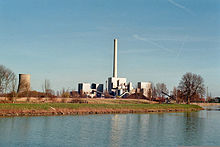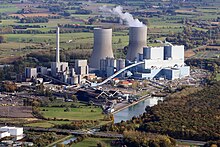Westphalia power plant
| Westphalia power plant | |||
|---|---|---|---|
| Aerial view of the power plant | |||
| location | |||
|
|
|||
| Coordinates | 51 ° 40 '49 " N , 7 ° 58' 11" E | ||
| country | Germany | ||
| Waters | Datteln-Hamm Canal (additional water cooling tower) | ||
| Data | |||
| Type | coal-fired power station | ||
| Primary energy | Fossil energy | ||
| fuel | Hard coal | ||
| power | currently 800 MW (electrical) :
|
||
| owner | RWE | ||
| Start of operations | 1963 | ||
| Chimney height | 200 m | ||
The Westfalen power plant is a large coal-fired power plant operated by RWE Power AG ( VEW until 2000 ) in the Hamm-Uentrop district ( Schmehausen district ) of the city of Hamm at the eastern end of the Datteln-Hamm Canal . It currently consists of Block E with 800 MW, newly built in 2014, which is fired with hard coal. Unit D, which was also newly built, was shut down in the commissioning phase in 2015 due to serious technical and economic problems.
The Thorium High Temperature Reactor 300 (THTR) is also located on the power plant site . It went into operation in 1983 and was taken out of service by the operator in 1989. The THTR dry cooling tower in Schmehausen was blown up on September 10, 1991. The innovative cable network construction of the cooling tower developed by Jörg Schlaich was taken up again in the construction of the Killesberg tower in Stuttgart. From around 1975 there were considerations to build a nuclear power plant on the power plant site ( Hamm nuclear power plant ); this plan was finally abandoned in 1995.
Status and history
Hard coal blocks A, B, C and ConTherm plant
The power plant started operation in 1963 with two 152 megawatt units (A and B). In 1969, another block (Block C) was added with a net output of 284 megawatts. While blocks A and B were designed for mixed combustion with oil, block C was designed from the outset for the sole use of hard coal. This is brought to the power plant via the Datteln-Hamm Canal; she came from the Ruhr area , now comes from Eastern Europe and overseas (Australia, South Africa and South America). At times, coal from mines on the Saar was also burned.
The Uentrop-Schmehausen canal end port is used for the transport of fuels and combustion products to and from the facility. The coal storage area of the power plant had a maximum capacity of 180,000 tons of hard coal until 2010. Such a supply is sufficient to operate all three power plant units at maximum load for more than a month.
In 1975 - after the first oil crisis - planning began for the Hamm nuclear power plant . It was to be built on this site, equipped with a pressurized water reactor from the Konvoi series and connected to the grid in 1990. The plans were never implemented.
Towards the end of the 1980s, the Westfalen power plant was equipped with a flue gas desulphurisation and denitrification system . In the course of this, two 150 meter high chimneys were replaced with a new 200 meter high chimney.
In 2001, the ConTherm system, a pyrolysis system upstream of Block C, went into operation. In these were smoldering of alternative fuels such as waste plastics calorific values, sorting residues, other waste, meat and bone meal and the like raw pyrolysis gas generated and pyrolysis coke, and then converted into electricity in the block C. On December 11th, 2009, the chimney collapsed in this pyrolysis plant and fell on the building belonging to it. The cause was a faulty insulation, which had led to enormous heat development, which had made the steel soft. There was property damage in the six-figure range. A profitability analysis carried out afterwards showed that waste with a high calorific value is no longer sorted to the extent necessary for the process. Instead, the materials, often the contents of yellow bags, end up in waste incineration plants. It was decided not to rebuild the overturned chimney.
For a number of years, up to fifteen percent of the thermal output of the power plant was used by adding other substances to the coal. These include petroleum coke, sewage sludge, as well as substitute or secondary fuels such as fiber residues, processed municipal and commercial waste and production residues that were considered "too valuable" for conventional waste incineration. Blocks A and B, which were designed for mixed firing, were basically only fired with hard coal.
The largest structure in the plant is the wet cooling tower of Block C, 122 meters high and 92 meters in diameter. Two older fan cooling towers, each 34 meters high, complete the cooling system.
Units A and B were taken offline in February 2011 and have been permanently shut down since 2014.
Unit C was taken offline in March 2015 and was finally shut down on March 31, 2016.
Construction of new hard coal units D and E
planning
In February 2007, RWE Power AG submitted a building application to the responsible district government for a coal -fired double-unit power plant with an output of 800 megawatts each. The plant will be built on the site of the once planned Hamm nuclear power plant , right next to the decommissioned high-temperature reactor THTR-300 .
Your exhaust gases are passed through two cooling towers, each 166.5 meters high (just as high as the never erected cooling tower of the abandoned Hamm nuclear power plant) so that no chimney is required for the new power plant. Compared to old coal-fired power plants of the same output and lower efficiency, the new units reduce carbon dioxide emissions by 2.5 million tons per year with a net efficiency of 46%. In comparison to this, modern combined cycle power plants have an efficiency of over 60%.
Units D and E would - if they were operated continuously - emit between 8.8 and 9.2 million tons of CO 2 annually, comparable to the emissions from Honduras in 2007. The newly added capacity of 1600 MW would only be at the Hamm site contrasted with a shutdown capacity of around 600 MW (from the beginning of 2015 around 900 MW). There would have been a significant increase in emissions at this location; Environmental groups criticized this. The lack of combined heat and power generation is also criticized.
Problems with the construction work
RWE Technology began construction work on the power plant in 2008. The foundation stone was laid in summer 2008 in the presence of Chancellor Angela Merkel . In 2010 it was planned to put a third coal dump into operation, which will also hold hard coal in stock for thirty days to meet the increased demand of the two new power plant units.
It was originally forecast that the system would go into operation in mid-2011 / early 2012. However, there were extensive defects in the two boiler frames; they were dismantled and new ones built. The associated work began in March 2010. This led to additional costs.
At the beginning of October 2013 there was a malfunction during the commissioning of Unit D: Hydrochloric acid was introduced into the boiler feed water. The amount was a few kilograms. Boiler tubes and a turbine were attacked. Block D should go online in June 2015. In September 2014, RWE announced that, due to renewed problems, no more forecasts for the commissioning of Unit D would be given. There was a legal dispute between RWE and the boiler manufacturer Alstom over defective boilers.
According to information from RWE, Block E went into commercial operation on July 2, 2014.
As of May 2015, there was no expected completion date for Block D. The common costs for blocks D and E rose from two billion euros to 2.4 to three billion euros. A number of local municipal utilities that have a financial stake in the power station are also affected.
In November 2014, it was also announced that RWE was raising claims against Imtech for possible fraud.
In December 2015, RWE announced that Block D would not be completed but would be closed. The reason is the lack of economic viability, which does not justify lengthy and expensive repairs and the completion of the plant. Before that, there had been serious problems with the construction and with the steel used, including hydrochloric acid getting into the boiler tubes. In February 2017 it was announced that RWE would like to sell all or part of Block D and is hoping for proceeds of more than 50 million euros.
See also
Web links
- Information material about the power plant (PDF file; 1.47 MB)
- 7 questions about the new block D / E (PDF file; 2.18 MB)
- Information material on the new block D / E (PDF file; 741 kB)
- Description of this sight on the route of industrial culture
- Hamm-Wiki: Westphalia power plant
Footnotes
- ↑ a b RWE information brochure: Westphalia power plant. A location full of energy.
- ↑ the Large Combustion Plant Ordinance of June 1983 required the retrofitting (or shutdown) of old plants. See also forest dieback
- ^ Chimney of RWE power plant Hamm-Uentrop collapsed , Märkische Allgemeine Online from December 11, 2009
- ↑ Off for CONTHERM system , Westphalian Gazette of 12 March 2010
- ↑ Westphalia coal-fired power station.
- ↑ a b RWE website.
- ↑ The furnace in power plant block C is out at the end of March , Westfälischer Anzeiger
- ↑ Endurance runner in retirement: Unit C of the Westfalen power plant in Hamm-Uentrop out of service. In: wa.de. April 1, 2016, accessed May 10, 2016 .
- ↑ Project presentation of the Hamm-Westfalen power plant ( memento from November 2, 2013 in the Internet Archive ) (PDF; 1.2 MB), accessed on May 30, 2013
- ↑ Carbon dioxide emissions (CO2), thousand metric tons of CO2 (CDIAC) , United Nations.
- ↑ Hamm hard coal power station (RWE)
- ↑ Embarrassing mishap: hydrochloric acid extends the shutdown of the new RWE power plant. In: Spiegel Online . October 7, 2013, archived from the original on July 11, 2015 ; accessed on June 9, 2018 .
- ↑ This is how coal gets into the power plant , Westfälischer Anzeiger of October 8, 2010
- ↑ Delayed to the network , Westfälischer Anzeiger of February 19, 2010
- ↑ Dismantling of the boiler frame has begun , Westfälischer Anzeiger of March 30, 2010
- ↑ Coal power plant in Uentrop costs 200 million more . In: Westfälischer Anzeiger , December 12, 2010. Retrieved December 8, 2012.
- ↑ Power plant another 200 million euros more expensive . In: Westfälischer Anzeiger , January 6, 2013. Retrieved January 6, 2013.
- ↑ https://www.wa.de/hamm/panne-rwe-kraftwerk-hamm-uentrop-salzsaeure-keine-gefahr-vorfall-nicht-meldepflichtig-3155223.html
- ↑ https://www.handelsblatt.com/unternehmen/industrie/rwe-salzsaeure-im-pannenkraftwerk/8894406.html
- ↑ Jürgen Flauger: The power plant in Hamm turns into a fiasco for RWE. In: Handelsblatt, September 17, 2014. Retrieved September 23, 2014.
- ↑ https://www.morgenweb.de/nachrichten/wirtschaft/regionale-wirtschaft/rwe-gegen-alstom-1.1890366
- ↑ Westphalia power plant. RWE website, accessed on May 11, 2015.
- ↑ Defects in the Hamm power plant: RWE threatens to lose billions , nw-news.de, September 22, 2014
- ↑ https://www.wn.de/Muenster/1727916-Stadtwerke-Beteiligung-in-Hamm-Ein-schlappes-Kraftwerk
- ↑ https://www.dailymail.co.uk/wires/reuters/article-2823451/Dutch-engineer-Imtech-says-investigating-fraud-allegations.html
- ↑ https://www.derwesten.de/wirtschaft/bestechung-beim-kraftwerksbau-id10037308.html
- ↑ RWE pulls the plug from Jürgen Flauger at Pannenkraftwerk . In: Handelsblatt , December 18, 2015. Retrieved December 18, 2015. Archived via Internet Wayback Machine ( Memento from November 16, 2017 in the Internet Archive ) on November 16, 2017.
- ^ Power plant block in Hamm-Uentrop for sale , WDR news. February 14, 2017. Archived from the original on November 16, 2017. Retrieved November 16, 2017.






